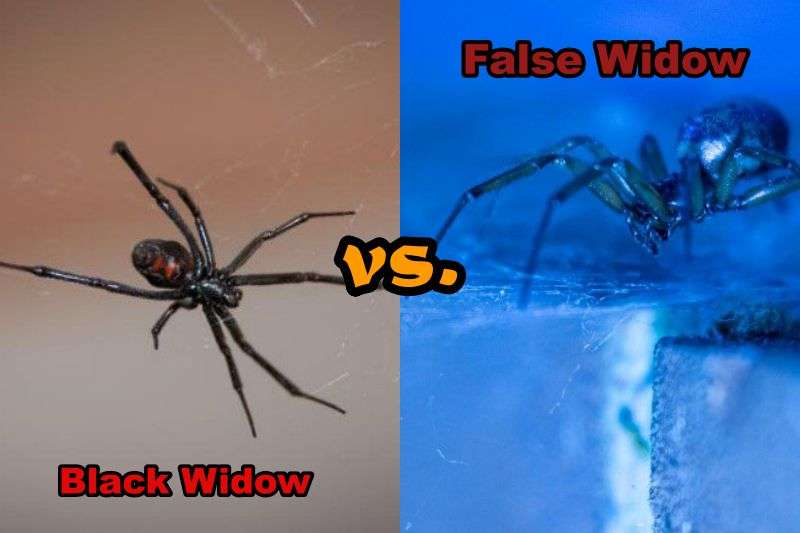Black Widows are spiders from the genus Latrodectus. They are also known as the True Widows. And that takes us to the “false” ones. Spiders from the genus Steatoda are the ones popularly called the False Widows.
This name comes from their resemblance in appearance to the Black Widows. The similarity in their looks is so much that they are often mistaken for each other.
Though they are look-alikes, they are plenty different from one another. In this article, we’ll talk about those differences. So, here we go, with five differences between Black Widow Spider vs. False Widow Spider.
Comparing Black Widow vs. False Widow
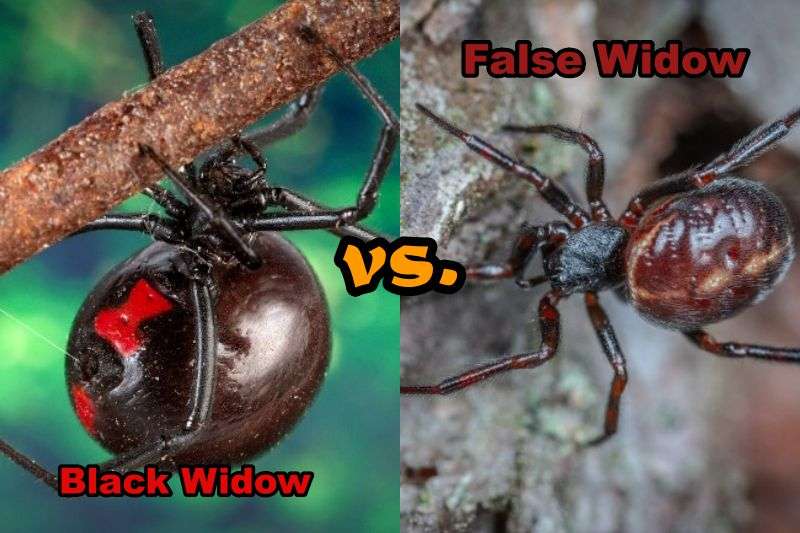
|
Characteristics |
Black Widow |
False Widow |
|
Size |
Males: 1.75 inches; Females: 1.5-2 inches (including legs) |
Males: 0.36 inches;
Females: 0.59-1.2 inches (including legs) |
|
Location & Habitat |
All over the globe, especially in North America.
Prefers urban, temperate forest & woodland ecosystems. |
All over the globe.
Prefers to stay mostly indoors and sometimes outdoors in the urban ecosystem. |
|
Appearance |
Females are brown or black with a red or orange hourglass on the abdomen.
Males have red or white and red spots on the abdomen. |
Both males and females have a tan or brown, or orange colored pattern on the back.
Males have bars or dots on their abdomen, while females have epigyne. |
|
Lifespan & Reproduction |
Males: 1-2 months; Females: 1-3 years
Egg sacs contain 100-400 eggs |
Males: 1-1.5 years; Females: Up to 6 years
Egg sacs contain 34-208 eggs |
|
Behavior |
Solitary and aggressive when surprised or protecting eggs | Solitary and mostly unaggressive but bites if threatened |
|
Venom Level |
Very venomous |
Mildly venomous |
Key Differences between Black Widow vs. False Widow
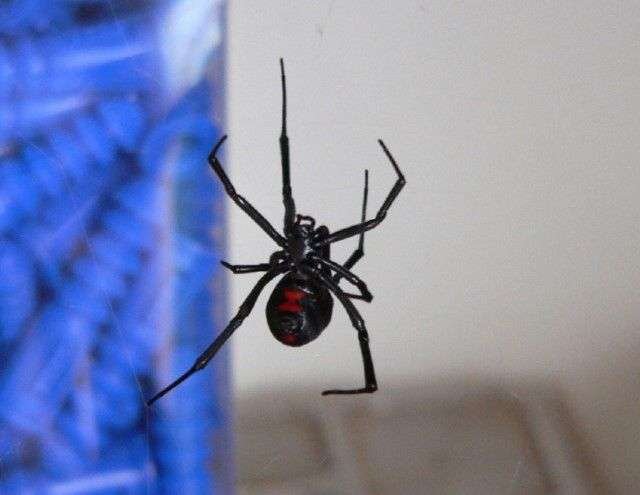
Black Widow is a spider species known for its frightening nature. While that nature isn’t shared with False Widow, their similar appearances bring comparison. Though these two spider species look similar to one another, their overall characteristics are starkly different.
Let’s take a look at the key differences between Black Widow vs. False Widow based on their attributes.
1) Black Widow vs. False Widow: Size
Black Widow and False Widow might seem similar in appearance, but their sizes differ. The body of a female Black Widow is around 0.12-0.39 inches and 1.5-2 inches if we include its legs. The males are smaller, almost half of the size of a female.
On the other hand, the female False Widows have an average size of 0.27-0.59 inches and 0.59-1.2 inches, including the legs. Male False Widows’ size is about 0.16-0.27 inches on average.
2) Black Widow vs. False Widow: Location and Habitat
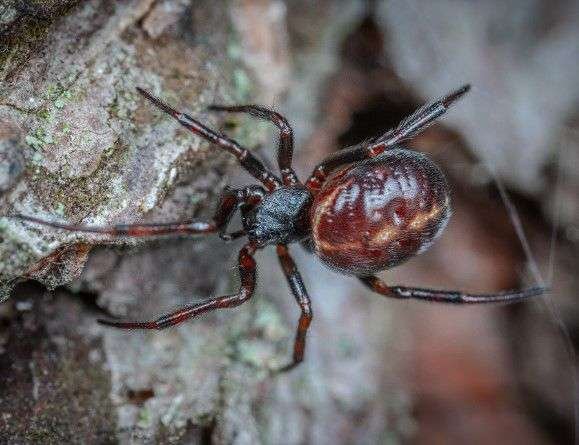
Both Black Widow and False Widow are found all over the world except Antarctica. Black Widows are found abundantly in North America, especially in the Okanagan Valley of British Columbia in Canada.
The distribution of False Widow also spans the whole world, including the coasts of North America, Europe, and Oceania.
Black Widows have a wide range of habitats, including urban areas, forests, and woodlands. They prefer a dry climate and tend to live under rocks and clutter.
False Widows are mostly found inside houses and sometimes even outside. They can be found all around the year in every season. They crawl on fences, poles, and walls, as well as in buildings and houses. Urban ecosystems are their preferred habitat.
3) Black Widow vs. False Widow: Appearance
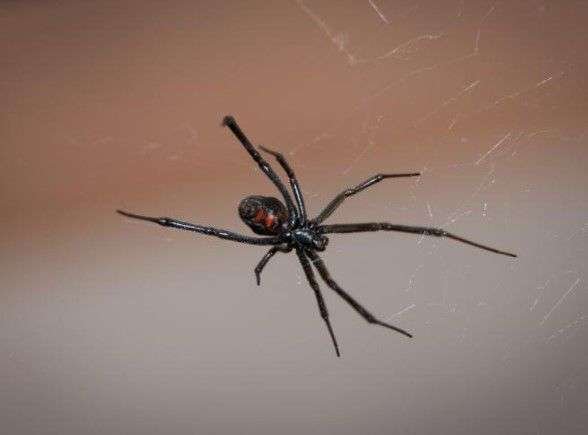
False Widow gets its name from the similarity of its appearance with that of a Black Widow. But while these two might resemble each other superficially, they have different appearances.
Differentiating them from their external looks might be difficult for a layman, but if someone looks closely enough, they can see the distinct characteristics of these two snakes.
Female Black Widows are bigger than False Widows and have shiny brown or black bodies as adults. The ventral side of their body has a distinct red or orange hourglass.
Some spiders have markings on the belly, while some are spotless. Some females can also be found in a light brown color, lacking any vivid marking.
Male Black Widows are smaller than their female counterparts and have red or sometimes red and white spots on the dorsal side of their abdomen. The marks range from single stripes of bars to dots. Juvenile Black Widows look similar to adult males.
False Widows, both males and females, have bulbous body that contains dark brown, tan, and orange colors. In some spiders, the back is completely brown with tan or light brown markings.
These colors make a skull-like pattern on the back. The head is a brownish orange that turns dark brown towards the mouth. In male False Widows, the ventral side of the abdomen is beige with dark brown markings.
The females, on the other hand, can be distinguished by their epigyne. The juvenile spiders look the same and cannot be distinguished externally.
4) Black Widow vs. False Widow: Lifespan and Reproduction
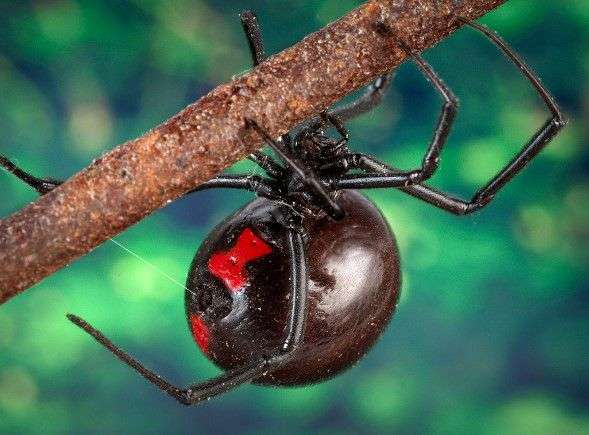
The lifespans of Black Widow and False Widow differ greatly. In the case of False Widows, the males live for 1-1.5 years, while the females have a significantly greater lifespan of around five years.
Some females have been noted to even live on for six years. Black Widows generally have a much shorter lifespan. Male Black Widows die after around only one month. Females hardly live up to 3 years.
Both Black Widow and False Widow reproduce rapidly. The mating season for Black Widows comes in late spring when the males and females come together.
The female Black Widow lays silken egg sacs in summer after being injected with the male’s sperm and fertilizing internally. Each egg sac carries around 100-400 eggs. After hatching from the eggs, the young offspring mature in 6-9 months.
Male False Widows show a special behavior during the courtship with a female where they scrape their abdominal teeth against the back of the carapace. It produces a sound meant for its female partner.
After mating, female False Widows produce a silkie brooding chamber where it stays for 2-10 days to lay egg sacs. Each egg sac contains about 34-208 eggs.
After 18 days, the offspring hatch out of the chorion but remain inside the egg sac for some period. During this time, they are able to prey on small insects to feed. The reproduction of False Widows is temperature dependent and thus can vary.
5) Black Widow vs. False Widow: Behavior
Both Black Widows and False Widows are solitary creatures that only get together with the others of their species during the mating season. Though none of these two are especially aggressive, Black Widows tend to act off more than False Widows.
They are not usually aggressive animals, but they get agitated when under threat or guarding their eggs. During this time, the Black Widow won’t hesitate to bite if surprised. The False Widow is the more temperate of the two. But still, it can resort to attack and bite if it feels threatened.
A special behavior is witnessed among the Black Widow spiders that led to its name. Female Black Spiders have been known to eat their male partner after mating.
While it’s a popular belief, the phenomenon is rare. Most such cases of sexual cannibalism are only seen in laboratory cages where the males have nowhere to run after mating.
Black Widows have also shown acts of sibling cannibalism, though even that is uncommon for the spiders.
6) Black Widow vs. False Widow: Venom Level
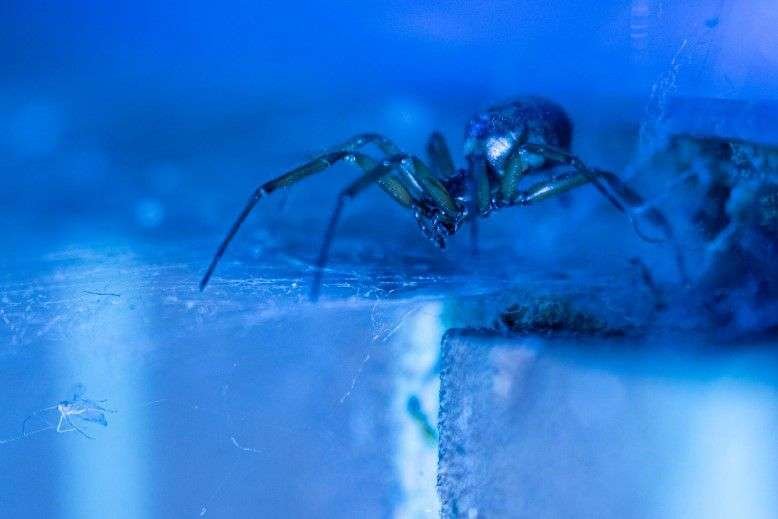
Another major difference between these two snakes is their venom levels. The Black Widow is a very venomous spider. Male Black Widows can also bite humans, but their venom is mild enough not to be dangerous.
But the female Black Widow is the formidable one. It has very large venom glands, and its venom contains latrotoxins, a type of neurotoxin which causes muscle spasms and extreme muscle pain, abdominal cramps, hyperhidrosis, and tachycardia.
It doesn’t lead to death and is treatable, but still, the pain from the bite is severe. The symptoms usually stay for 3 – 7 days, but there have been cases where the side effects from the venom stayed on for weeks.
False Widow is far less dangerous than its look-alike. The spider is venomous, but its venom is very mild, and only female False Widows bite. The bite of this snake is not really felt, but intense pain soon develops in the bitten area, as well as swelling.
The pain and the swelling persist for around three days and take on a bluish tinge. Since False Widows are not an aggressive spider species, there have been a small number of cases of them biting people.
This is where the comparison of Black Widow vs. False Widow ends. The spiders may look alike, but as we see, they are poles apart from one another.
One lesson we learn from these “widows” is that similarity in looks does not translate to the similarity in nature. With that philosophical note, this article ends here. Tell us your thoughts in the comments and before you leave, make sure to peek at our other articles on spiders and other exciting animals.
Also Read:
Anamika has a fascination with all living things. Being a Zoology student, she loves to know new interesting things about animals. She’s also a very keen fan of manga and anime. Writing is her passion, and writing about her favorite things is her boost of serotonin.
